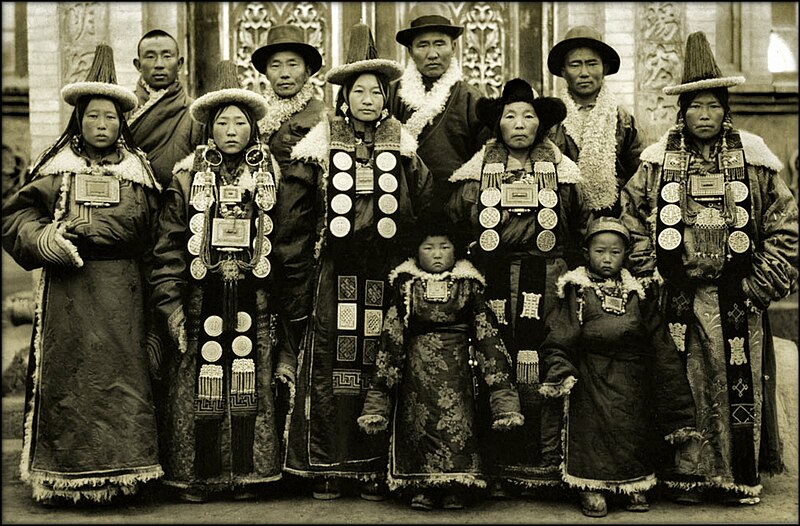English: Original description from the Flickr user:
Entitled: A Family In Lanchow, China [1944] Fr M Tennien [RESTORED]. I did the usual spot and defect removal, adjusted contrast, and added a sepia tone. Overall there was very little needed to do for this very well maintained image.
Another photograph from the extensive holdings of The University of Southern California's Internet Mission Archive taken by a Father Mark Tennien, a cleric from one of the religious missions in Lanzhou (then known as Lanchow). Again, the mission statement of the archive is as follows:
"The Internet Mission Photography Archive offers historical images from Protestant and Catholic missionary collections in Britain, Norway, Germany, and the United States. The photographs, which range in time from the middle of the nineteenth to the middle of the twentieth century, offer a visual record of missionary activities and experiences in Africa, China, Madagascar, India, Papua-New Guinea, and the Caribbean. The photographs reveal the physical influence of missions, visible in mission compounds, churches, and school buildings, as well as the cultural impact of mission teaching, religious practices, and Western technology and fashions. Indigenous peoples' responses to missions and the emergence of indigenous churches are represented, as are views of landscapes, cities, and towns before and in the early stages of modern development."
Lanchow, or as now known, Lanzhou 蘭州, has lived under a variety of names in the northwest Gansu province, and is probably one of the oldest continuously inhabited cities in China. It was also one of the key cities on the northern leg of the the famed silk road. At the crossroad of many cultures, it was the home to the Qiang people when it fell under Qin rule in the 6th Century BC. Thereafter a steady stream of invasions and dynastic shifts allowed it to be ruled by a variety of foreign cultures and nations (including Tibet, which should give those who claim that Tibet was always a part of China some more history to try to rewrite). During the volatile warlord period of the 1920-1930s, Lanzhou was an important transfer point for Soviet communist influence and support into China.
Father Tennien, on 28 SEP 1944 wrote:
"This is a photograph of a family in Lanchow. The women wear square amulets hanging from their necks. The ornaments on their dresses are of solid silver. The family is wearing hats and heavy coats."
The clothing on the family in the picture is unique but shows similarity to both that of tradition Qiang and Tibetan cultures, however there seems to be a bit of Mongolian thrown in as well. I personally am not well versed with any of the Chinese ethnic minorities (officially 56 are recognized at last count) to know the subtle nuances such as cultural difference in dress. If there is anyone out there that knows who or what ethnic group these people belong too, please speak up and educate the rest of us.
English: This is probably a
Yugur family, looking at their hat and ornaments, see the modern version here :
[1][2][3][4].Yugur are descendant of Mongols and Ouigours, leaving in Gansu, near Lanzhou.
Popolon (
talk) 00:06, 19 June 2013 (UTC).
Français : Il s'agit probablement d'une famille
Yugur, d'après leurs chapeaux et leurs ornements. On peut voir des versions plus contemporaines de leurs costumes traditionnels :
[5][6][7][8]. Les Yugurs sont des descendants des Mongols et des Ouigours, vivant dans le
Gansu, près de Lanzhou.
Popolon (
talk) 00:06, 19 June 2013 (UTC).



